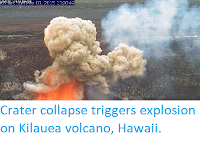Mount Kilauea, a 1247 m shield volcano (dome shaped volcano made up largely of layers of lava) on eastern Hawai'i (or 'Big') Island, began erupting on Thursday 3 May 2018, when lava began to spew from a 150 m rift on the eastern flank of the volcano, prompting local authorities to enforce a mandatory evacuation in the neighbourhoods of Leilani Estates and Lanipuna Gardens, both about 40 km from the crater of the volcano. Since then about 35 homes in the Leilani Estates have been destroyed by lava, although the main threat to human safety is not considered to be the lava, which is slow moving and can generally be avoided, but from poisonous sulphur dioxide gas which is also emitting from the fissure.
Burning homes ignited by lava in Leilani Estates, Hawai'i, on 6 May 2018. Trevor Hughs/USA Today.
The eruption has caused a 300 m drop in the level of the Halema‘uma‘u Lava Lake in the caldera of Mount Kilauea, as lava escapes from the fissure, which has concerned vulcanologists at the Hawai'i Volcano Observatory, as the shrinking lake has led to debris falling into the crater, something which has historically led to explosive eruptions on the volcano when the lava lake begins to refill and finds its way obstructed (explosive eruptions on shield volcanoes are otherwise extremely rare. This last happened in 1924, when about 14 tonnes of material was thrown from the caldera in a series of explosive eruptions caused by steam building up beneath debris that had fallen into the crater, throwing a material up to 270 m from the crater and resulting in the death of an onlooker.
Ash column over Mount Kilauea on 3 May 2018. USGS.
The islands of Hawai'i have formed as a result of hotspot volcanism, with a mantle plume hotspot currently located under Big Island, Hawai'i, and each of
the other islands being the result of previous activity from the same
hotspot, with the oldest Islands in the northwest and newest in the
southeast. A volcanic hotspot is an area where magma from deep inside
the Earth is welling up through the overlying plate (in this case the
Pacific) to create volcanism at the surface. Volcanoes move as they
erupt, swelling as magma enters their chambers from bellow, then
shrinking as that magma is vented as lava.
The position of the Hawai'i Hotspot relative to the islands of Hawai'i. Joel Robinson/USGS/Wikimedia Commons.
See also...
Follow Sciency Thoughts on Facebook.









